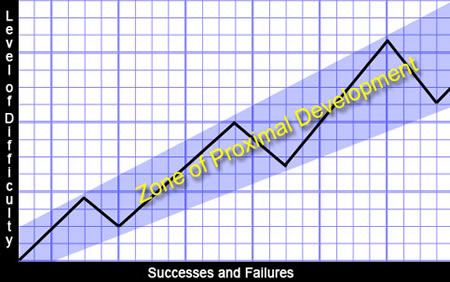Zone of Proximal Development
Russian psychologist Lev Vygotsky developed the Zone of Proximal Development (ZPD) as the metaphorical distance between what a learner can achieve on his or her own versus what he or she can accomplish with a help of a more experienced other (Zone of Proximal Development, 2008).
Capturing this optimal level of instruction and learning is accomplished in games through a performance feedback loop. For example, in the Nintendo Wii game Mario Strikers: Charged, the player controls a team of Super Mario Brothers characters as they play a stylized version of soccer against other teams. The game comes with a tutorial called Strikers 101, consisting of "missions" which highlight the use of one of the many techniques needed to master play.
The true scaffolding of the game, though, takes place during the tournament mode. When a player begins a tournament but has never played against other teams before, the level of difficulty is fairly low (in terms of plays, passes and shots to the goal that the enemy takes). However, with every win, the game becomes exponentially more difficult until the point where most players will lose at least one game.
After losing a game, the level of difficulty is lessened. But, if a win follows the initial loss, the difficulty level is raised again but not as high as before the initial loss.

By using a process of gradual evaluation and difficulty modification, the game hones in on the actual edge of performance of the player. By the time ten or eleven games have been played, the in-game opponents are likely to have a level of difficulty very close to the player’s ZPD.
Therefore, the ZPD lies between the highest level of difficulty the player is competent at with minimal game support and the lower level of difficulty, below which the game would be too easy for the player since he or she has mastered all the skills.
